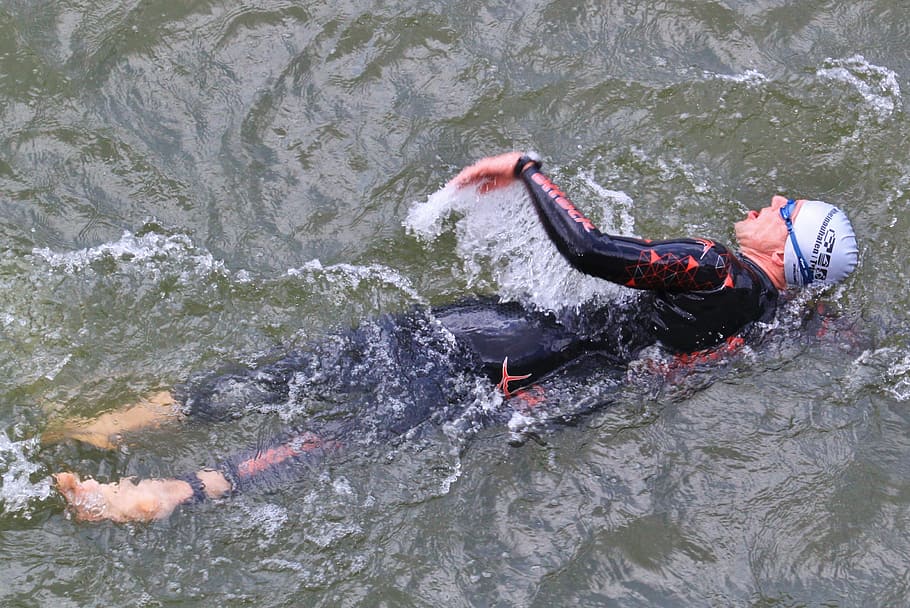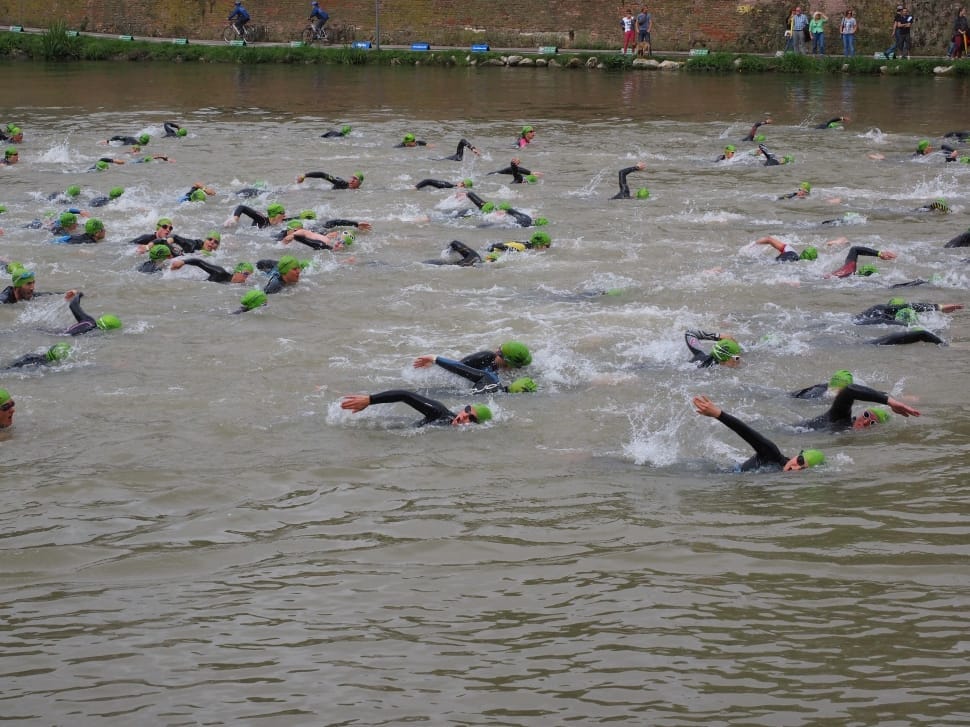Triathlon Swimming: Best Swim Stroke for a triathlon
Very few (if any) triathlons have been won because of the triathlete’s swimming ability. However, many triathletes have not finished a triathlon because of a lack of swimming skills. Triathletes, inexperienced with swimming, can find the swimming overwhelming, intimidating and fearful. Learning how to incorporate the breaststroke or a modified breaststroke can help eliminate these apprehensions and be the difference between finishing the swim, thus the triathlon, or being paddled to shore in a canoe.
What Stroke Must Be Used?
In the world of competitive swimming there are four competitive strokes. Backstroke, Breaststroke, Butterfly and Freestyle. Some may debate there is a fifth, underwater dolphin kick, but that is another debate for another time. Each of these strokes have specific guidelines that must be followed in competition. Failure to do so results in disqualification from the event. Though not recommended, each of these strokes can be used in a triathlon. Triathlons allow swimmers to utilize any stroke and as many different strokes as preferred to propel themselves through the water. Most participants swim the front crawl (freestyle stroke) since it is the most efficient and fastest stroke. Speed is not always the highest priority when swimming in a triathlon. Being able to complete the swim leg allows the athlete to get back to more familiar ground (pun intended). Not only can the competitive strokes be used but others as well, e.g. sidestroke, elementary backstroke, trudgen crawl even treading water. Failure to adhere to the standards of the specific strokes will not result in a disqualification in a triathlon competition.

Some Specifics
This article is going to focus on a specific stroke, the breaststroke. (or at least a modified version of the breaststroke) and the benefits of swimming it in a triathlon. First, a few distinctions of the breaststroke. It is the only stroke, of the competitive strokes, with an underwater recovery. The body, when swimming breaststroke, is in the least efficient position to move through the water. For many, the stroke is very difficult to learn because of the complexity and coordination required. Due to the underwater recovery of the stroke, inefficient body position and the highly technical skills needed, it is the slowest of the competitive strokes. So why would anyone want to swim a stroke that is more difficult, less efficient and slower? Remember, we are not swimming a true breaststroke but a modified breaststroke. The rules required in competitive swimming are not mandatory when swimming the breaststroke in a triathlon. This allows adjustments that provides triathletes the ability to relax and build confidence while advancing through the water.
In A Nutshell
There are three good reasons to use the breaststroke during a triathlon. It provides an opportunity to recover or “rest” while still advancing through the water. If a swimmer has gone off course, they are able to gain their bearings. Thirdly, swimming a modified breaststroke enables the athlete to keep the head above water, making sighting more natural and much easier.
Keep Moving While You Rest
The frantic frenzy that can be created by friendly, fellow participants trying to swim around, over, under and through competitors can put even the most experienced swimmer in a distressed state. Often swimmers will stop, tread water to regain their composure. Stopping cost time and positions. A better solution, slow down, relax and swim breaststroke. The arms and legs slow down allowing the swimmer to recover, collect their thoughts and refocus. The head can be kept above the water allowing the swimmer to catch their breath.
Do You See What I See?
Swimming in a pool one is guided by the lane lines and the black line on the bottom of the pool. It provides direction and security. There is a consistent path, back and forth, wall to wall. Open water swimming can become disorienting at times with the head in the murky water. When swimming freestyle, the best way to breathe is turning the head to the side. To maintain awareness of their position freestyle swimmers will lift their head to look forward for buoys or landmarks. This is called “sighting” and is a skilled that should be learned when swimming the forward crawl.
However, when swimming breaststroke a breath is taken with each stroke, with the head looking forward, not to the side. Swimming breaststroke allows swimmers to sight with each breath because their head is looking forward. Lifting the head with each breath enables the swimmer to continually get an idea of where they are, who is around them, and where they are headed. Gaining one’s bearings can reduce anxiety and provide assurance they are headed in the right direction. After determining their location and catching their breath they can resume swimming freestyle.
If a swimmer continually loses direction when they place their face in the water, they should try swimming breaststroke with the face out of the water. This allows the swimmer to keep their eyes fixed on a buoy or landmark. It may be a little slower, but it beats treading water or abandoning the race. Remember, the shortest distance between two points is a straight line and the finish line.
Final Tips and Pointers
Learning the fundamentals will provide greater efficiency and build confidence in the ability to use the stroke. Those who believe breaststroke could improve their swimming performance in a triathlon should devote some time to learning and improving stroke mechanics in your workout. Learn how to transition from swimming freestyle to breaststroke back to freestyle. Swim a few hundred yards/meters of breaststroke to keep the skills fresh. When possible as with any of your swim training practice in open water when and if available.
One bonus tip. Don’t expend all your energy on the shortest leg. Usually time can be made up on the bike and run. Swimming “breaststroke” can be the key to not only finishing the swimming leg but help you conserve energy needed for the longer legs of cycling and running.
Need some help with your triathlon swimming skills? Hire a private swim instructor to coach you and develop a training plan at your home or community pool today!
Steve Breeding’s bio:
Swim Instructor in The Woodlands, TX
Steve Breeding – has over 30 years coaching experience with Summer League swim teams, USS age group teams, Public and Private High Schools along with youth and adult triathlon teams – clients range from beginners to adults – summer league swimmers - to US Olympic Trials Qualifiers, sprint triathlons to Ironman Championship participants. His greatest satisfaction is teaching adults, who thought they couldn’t swim, that they can.
ABOUT SUNSATIONAL SWIM SCHOOL
Sunsational Swim School is the 🥇 #1 rated provider of private, at-home swimming lessons in America. We have specialized swim instructors for students ages 6 months to adult, beginner to advanced. Featured on ABC, CBS, Impact 100, The List and others, Sunsational instructors have a minimum of 2 years of teaching experience, are CPR certified and insured, and have collectively taught over 302,223 lessons for more than 74,415 students nationwide!




